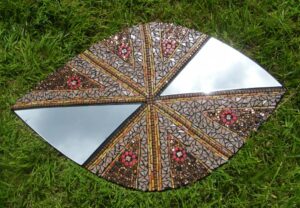“Contemporary art is much more mosaic than you can imagine.”, explained in 2017 in an interview on Artribune Alfonso Panzetta, curator of the Biennial of Contemporary Mosaic in Ravenna, an exhibition dedicated to mosaic technique, with an eye to its manifestations in contemporary art. “Mosaic is everywhere; you just have to start recognizing it. Today the mosaic is made with different objects than the tile. In this sense, the tile has undergone a metamorphosis. Using objects to compose a figure, as occurs in assembly or accumulation, is a concept inherited from the mosaic technique. It also exists in painting, in the fragmentation of the brushstroke or even in the more technical concept of pixels”. This observation immediately contextualizes the work of Charlotte A. Cornish, an eclectic English artist active in various fields (drawing, painting, crafts, design, digital art, fashion, graphics, illustration, sculpture, public art), who makes an integral part of her creative production through the art of mosaics, confirming the relevance of this artistic genre.
The artist began to approach this technique in 2007, with the idea of producing a selection of works that were immediately readable and that emit colored reflections with the light and with this intent, after the first period in which she focused on marble inserts, she approached the glass, a fascinating material in its versatility, with a long artistic and symbolic tradition behind it. The combination of fragments of tiles and glass tesserae creates an impression of movement and three-dimensionality of the mosaic surface that acquires a sculptural value, while the refraction of light, always different according to the alternation of light sources at other times of the day and of the inclination of the work, expands its range of action on an environmental scale. The idea of reflection appears central in the series entitled “Mirror”, consisting of shaped mirrors surrounded by splinters of tiles and glass paste inserts, selected based on texture and color. These combinations create a point-like and vibrant chromatic mixture, which the eye perceives as gradations and shades.
The grounded and unifying element of these works is light, which becomes an all-encompassing experience and adamantine thought. At the same time, the expressive value is entrusted to the chromatic and tactile research of materials. Light, an intangible but physically perceptible element, is the essence of the visible and functions as a perceptive gateway that makes it possible to overcome form to arrive at the pure sensation. In light, matter loses consistency and weight to exist as a pure image, in which floating signs are suspended in space and time. The Mosaic is used here as a medium of lines, signs, and colors in which a mysterious visual memory is concealed, a sort of extension in the presence of things and the simultaneous persistence of archetypes taken from various visual cultures. Today, Mosaic is a syncretic discipline that places itself at the crossroads of traditional knowledge and languages bearing different identities that become essential vehicles of exchange with current events. In fact, Charlotte A. Cornish’s works incorporate suggestions and stylistic features from various historical periods (starting from the inevitable oriental reference to Byzantine mosaic art to arrive at Art Deco and Futurism) translated into a superior uniformity of language, which reflects the stylistic coherence of the author.
Each work expresses a precise emotional setting and derives from the artist’s sensory approach to a landscape in which she recognizes herself or her memory. References to nature recur, which is evoked by combinations of tesserae in which different shades of abstraction and figuration coexist: the leaves, flowers, earth, water, and sky are stimulated through their chromatic vibrations, which visually synthesize a complex impression in which the intuitions of our perceptive organs and the abstract idea that they have produced over time in our imagination converge. Simultaneously, the figurative inserts, overly stylized to the point of sometimes being assimilated to abstract signs, return the same perception due to the millennial process of creative appropriation through which man has developed different visual codes to interpret natural forms.
Talking about the works in the “Mirror” series, we could also speak of settings because these artworks refer to the time and place where the artist created them, where the viewer is invited to immerse himself with his mind and gaze. As suggested by the title, another central element of these works is precisely the mirror, which re-introduces all the multiform variability of life that flows back into the mosaic’s crystallized harmony.
 Charlotte, A. Cornish, The Shield (Mirror). Mosaic on wood board, 2020
Charlotte, A. Cornish, The Shield (Mirror). Mosaic on wood board, 2020
 Charlotte, A. Cornish, Rocket (Mirror). Mosaic on wood board, 2009
Charlotte, A. Cornish, Rocket (Mirror). Mosaic on wood board, 2009
 Charlotte, A. Cornish, Recherché (Mirror). Mosaic on wood board, 2020
Charlotte, A. Cornish, Recherché (Mirror). Mosaic on wood board, 2020
The reflecting power of the mirror returns the observer’s image, forcing him to a confrontation, as a sort of memento mori, and at the same time reverberates the diversity of human identity that propagates in the dust of mirrored tiles. But the continuity of life is also manifested in the mirror’s attitude to create impossible spaces and generate images that could turn into something else. In her work, Charlotte A. Cornish seems to want to overshadow the artwork itself and suggests to the viewer to do the same, giving up the vain reflection of one’s ego to use the mirror as a device for dissolving the self into the natural elements that follow the decomposition process carried out by the mosaic tiles that surround it.
Info:
www.saatchiart.com/CharlotteACornish

Actor and performer, he loves visual arts in all their manifestations.






NO COMMENT